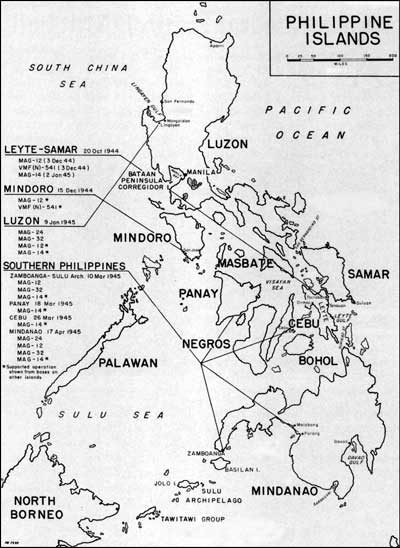| Marines in World War II Commemorative Series |
|
. . . AND A FEW MARINES: Marines in the Liberation of the Philippines by Captain John C. Chapin, USMCR (Ret) Marine Artillery Arrives On 20 October, four Army divisions made landings on the east coast of Leyte. Following them in on the next day (21 October) was not an element of Marine aviation but the Marine V Amphibious Corps (VAC) Artillery. This anomaly occurred because the normal heavy artillery of the Army's XXIV Corps had been detached to support the Marine assault in the Mariana Islands. Once there, they were not available in time for the Leyte landings, and so the Marines' big guns had been sent from Pearl Harbor to support the Army infantry in the Philippines. Thus, Brigadier General Thomas E. Bourke led ashore the 1,500 Marines of the 11th 155mm Gun Battalion, the 5th 155mm Howitzer Battalion, and the Corps Artillery Headquarters Battalion. Moving quickly into action, the cannoneers initially fired in support of the Army's XXIV Corps from positions near the beach head. Major General Ralph J. Mitchell
As Commanding General, 1st Marine Aircraft Wing, Mitchell was the original motivating force behind the assignment of Marine aviation to the Philippines. Headquarters duty forced him to remain in Bougainville, with only occasional visits to his subordinates at the scene of action. He was in charge of the 1st MAW from April 1943 to June 1945. Both the Army and the Navy awarded him a Distinguished Service Medal, and he was also awarded a Legion of Merit. Born in 1889, commissioned in 1915 after graduating from the U.S. Naval Academy, Mitchell took an early interest in flying. He earned his Naval Aviator wings in 1921, and served with a Marine squadron in Nicaragua in 1929-30. While there he was awarded the Distinguished Flying Cross. In 1939 he was Director of Aviation at Marine Corps Headquarters. After the war, he retired in 1948 as a lieutenant general, and he died in 1970. Manning one of the weapons in Battery B of the 11th 155mm Gun Battalion were PFCs Frank Pinciotti, Shelby Heimback, and Walter Dangerfield. As Dangerfield remembered, after they landed and emplaced their gun, the three of them decided that "it was time [for the Marines] to have some recognition." Pinciotti came up with the idea of painting "By the grace of God and the help of the Marines, MacArthur has returned to the Philippines" on the cover of a wooden ammunition box and hanging it over the barrel of their Long Tom. "Soon one of our officers ordered us to take it down, as MacArthur would come around to inspect." Apparently other Marines saw the sign before it came down and according to reports, before long, it appeared elsewhere in the islands. It has also been reported that General MacArthur saw one of the signs and wanted the perpetrator or perpetrators found out and punished. But this perhaps is an apocryphal story.
During the critical naval Battle of Leyte Gulf (23-26 October), there was concern for a Japanese naval attack to the rear of the Marine artillerymen. The threat ended when the enemy fleet was driven off. As the infantry divisions fought their way inland, the Marine artillery made a series of displacements to keep pace with the forward movement. Each move was greatly hindered by the heavy rains in November which turned the primitive roads into muddy swamps. Because of the nature of the terrain, visual observation for fire adjustment was frequently impossible, but the 12 L-4 (Cub) liaison planes available to the Marine artillerymen proved invaluable for spotting results. On the night of 6-7 December, the Buri airfield where these planes were based was first bombed and then assaulted by a force of enemy paratroopers who had been dropped to join up with local Japanese infiltrators. Their combined force of 350-450 men was met by 30 men of the Corps Artillery Air Section, who fortunately were soon joined by other Marine and Army personnel at the airstrip. A stalemate ensued, with the enemy holding one part of the base, and the Americans the other part. Meanwhile, the Cub planes continued to operate on the strip. Finally, the evening of 10 December, additional troops cleared out the Japanese.
That dramatic episode concluded the action by the V Amphibious Corps Artillery on Leyte. It was relieved on the following day when the Army's XXIV Corps Artillery arrived from Saipan. The Marine artillery battalions left for Guam on 13 December, with an Army commendation for their "splendid performance" in fire support missions for the Army infantry divisions.
|





